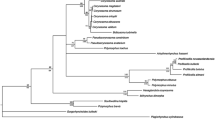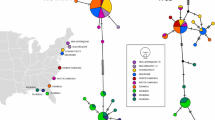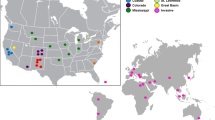Abstract
Host specificity is a key variable of the niche breath of parasites that can be an important determinant of a parasite’s ability to invade new areas. There is increasing evidence that many parasite species may comprise a variety of genetically variable lineages, which differ in host specificity and geographic range. In this study, we (1) explored the extent of diversity in the invasive parasitic barnacle Loxothylacus panopaei (Rhizocephala) infecting mud crabs (2) examined the geographic origin for the invasive lineage and (3) assessed if further southward spread of the parasite may be impeded. Along the US Atlantic coast, L. panopaei infects different hosts in its invaded range (Chesapeake Bay to north of Cape Canaveral) compared to one portion of the native range in Southeast Florida. This difference was reflected in genetic lineages on two independent loci, mitochondrial cytochrome oxidase I and nuclear cytochrome c. Both loci were concordant in that they showed one lineage infecting crabs of the genus Panopeus in the native range and one lineage infecting Eurypanopeus depressus and Rhithropanopeus harrisii hosts in the invaded range and in the Gulf of Mexico, thus indicating Gulf of Mexico populations as the most likely source of introduction into Chesapeake Bay. Interestingly, the nuclear marker resolved an additional lineage of parasites infecting panopeid hosts in the native range. All three parasite lineages were well supported, but a decision about species status must await further analyses. Since its introduction in the 1960s, the invasive L. panopaei lineage has expanded its range southward along the US Atlantic coast, now almost reaching the northern limit of native Panopeus-infecting lineages at Cape Canaveral, Florida. We hypothesized that parasite-free E. depressus in Southeast Florida, living in sympatry with infected panopeid populations, might be resistant to infection by the invasive lineage. Our infection experiments rejected this hypothesis, suggesting that any impediment to further southward range expansion might be expected from temperature regimes of the subtropical zoogeographic region south of Cape Canaveral.




Similar content being viewed by others
References
Alvarez F (1993) The interaction of a parasitic barnacle, Loxothylacus panopaei (Cirripedia, Rhizocephala), and three of its host crab species (Brachyura, Xanthidae) along the east coast of North America. Ph.D. Dissertation, University of Maryland, 188 pp
Alvarez F, Hines AH, Reaka-Kudla ML (1995) The effects of parasitism by the barnacle Loxothylacus panopaei (Gissler) (Cirripedia, Rhizocephala) on growth and survival of the host crab Rhithropanopeus harrisii (Gould) (Brachyura, Xanthidae). J Exp Mar Biol Ecol 192:221–232
Antonovics J (2009) The effect of sterilizing diseases on host abundance and distribution along environmental gradients. Proc R Soc Biol Sci Ser B 276:1443–1448
Bickford D, Lohman DJ, Sodhi NS, Ng PKL, Meier R, Winker K, Ingram KK, Das I (2007) Cryptic species as a window on diversity and conservation. Trends Ecol Evol 22:148–155
Boschma H (1955) The described species of the family Sacculinidae. Zool Verhandel Leiden 27:1–76
Briggs JC (1974) Marine zoogeography. McGraw-Hill, New York
Brown JH (1984) On the relationship between abundance and distribution of species. Am Nat 124:255–279
Brown JH (1995) Macroecology. University of Chicago Press, Chicago
Carlton JT (1996) Biological invasions and cryptogenic species. Ecology 77:1653–1655
Farrapeira CMR (2010) Shallow water Cirripedia of the northeastern coast of Brazil: the impact of life history and invasion on biogeography. J Exp Mar Biol Ecol 392:210–219
Farrapeira CMR, Melo AVOM, Barbosa DF (2008) Introduction of Loxothylacus panopaei (Cirripedia: Rhizocephala), a marine non-indigenous parasitic castrator in estuarine area of Recife, Pernambuco, Brazil. Biociências 16:157–159
Hare MP, Avise JC (1996) Molecular genetic analysis of a stepped multilocus cline in the American oyster (Crassostrea virginica). Evolution 50:2305–2315
Hines AH, Alvarez F, Reed SA (1997) Introduced and native populations of a marine parasitic castrator: variation in prevalence of the rhizocephalan Loxothylacus panopaei in xanthid crabs. Bull Mar Sci 61:197–214
Høeg JT, Lützen J (1995) Life cycle and reproduction in the Cirripedia Rhizocephala. Oceanogr Mar Biol 33:427–485
Huelsenbeck J, Ronquist F (2001) MrBayes: Bayesian inference of phylogeny. Bioinformatics 17:754–755
Knowlton N (2000) Molecular genetic analyses of species boundaries in the sea. Hydrobiologia 420:73–90
Krasnov BR, Poulin R, Shenbrot GI, Mouillot D, Khokhlova IS (2005) Host specificity and geographic range in haematophagous ectoparasites. Oikos 108:449–456
Kruse I, Hare MP (2007) Genetic diversity and expanding nonindigenous range of the rhizocephalan Loxothylacus panopaei parasitizing mud crabs in the western North Atlantic. J Parasitol 93:575–582
Kuris AM (1974) Trophic interactions—similarity of parasitic castrators to parasitoids. Q Rev Biol 49:129–148
Lee T, Ó Foighil D (2004) Hidden Floridian biodiversity: mitochondrial and nuclear gene trees reveal four cryptic species within the scorched mussel, Brachidontes exustus, species complex. Mol Ecol 13:3527–3542
Miura O, Kuris AM, Torchin ME, Hechinger RF, Dunham EJ, Chiba S (2005) Molecular-genetic analyses reveal cryptic species of trematodes in the intertidal gastropod, Batillaria cumingi (Crosse). Int J Parasitol 35:793–801
Miura O, Torchin ME, Kuris AM, Hechinger RF, Chiba S (2006) Introduced cryptic species of parasites exhibit different invasion pathways. Proc Natl Acad Sci USA 103:19818–19823
Moore WS (1995) Inferring phylogenies from mtDNA variation—mitochondrial-gene trees versus nuclear-gene trees. Evolution 49:718–726
Nei M (1987) Molecular evolutionary genetics. Columbia University Press, New York
Palumbi S (1996) Nucleic acids II: the polymerase chain reaction. In: Hillis D, Moritz C, Mable B (eds) Molecular systematics, 2nd edn. Sinauer Associates, Massachusetts, pp 205–247
Palumbi SR, Cipriano F, Hare MP (2001) Predicting nuclear gene coalescence from mitochondrial data: the three-times rule. Evolution 55:859–868
Posada D, Buckley T (2004) Model selection and model averaging in phylogenetics: advantages of Akaike information criterion and Bayesian approaches over likelihood ratio tests. Syst Biol 53:793–808
Posada D, Crandall K (1998) Modeltest: testing the model of DNA substitution. Bioinformatics 14:917–918
Posada D, Crandall K (2001) Selecting the best-fit model of nucleotide substitution. Syst Biol 50:580–601
Poulin R (2007) Evolutionary ecology of parasites. Princeton University Press, New Jersey
Poulin R, Keeney DB (2008) Host specificity under molecular and experimental scrutiny. Trends Parasitol 24:24–28
Prinzing A, Durka W, Klotz S, Brandl R (2002) Which species become aliens? Evol Ecol Res 4:385–405
Reinhard EG, Reischman PG (1958) Variation in Loxothylacus panopaei (Gissler), a common sacculinid parasite of mud crabs, with the description of Loxothylacus perarmatus, n. sp. J Parasitol 44:93–99
Rieseberg LH, Beckstrom-Sternberg S, Doan D (1990) Helianthus annuus ssp. texanus has chloroplast DNA and nuclear ribosomal RNA genes of Helianthus debilis ssp. cucumerifolius. PNAS 87:593–597
Rivas LR (1964) A reinterpretation of the concepts ‘sympatric’ and ‘allopatric’ with proposal of the additional terms ‘syntopic’ and ‘allotopic’. Syst Zool 13:42–43
Sarver SK, Landrum MC, Foltz DW (1992) Genetics and taxonomy of ribbed mussels (Geukensia spp.). Mar Biol 113:385–390
Saunders N, Kessler L, Avise J (1986) Genetic variation and geographic differentiation in mitochondrial DNA of the horseshoe crab, Limulus polyphemus. Genet Breed 112:613–627
Schubart CD, Neigel JE, Felder DL (2000) Molecular phylogeny of mud crabs (Brachyura: Panopeidae) from the northwestern Atlantic and the role of morphological stasis and convergence. Mar Biol 137:11–18
Swofford D (2001) PAUP*. Phylogenetic analysis using parsimony, version 4.0b10. Sinauer, Sunderland
Tamura K, Dudley J, Nei M, Kumar S (2007) MEGA4: molecular evolutionary genetics analysis (MEGA) software version 4.0. Mol Biol Evol 24:1596–1599
Thresher RE, Werner M, Hoeg JT, Svane I, Glenner H, Murphy NE, Wittwer C (2000) Developing the options for managing marine pests: specificity trials on the parasitic castrator, Sacculina carcini, against the European crab, Carcinus maenas, and related species. J Exp Mar Biol Ecol 254:37–51
Tolley SG, Winstead JT, Haynes L, Volety AK (2006) Influence of salinity on prevalence of the parasite Loxothylacus panopaei in the xanthid Panopeus obesus in SW Florida. Dis Aquat Org 70:243–250
Van Engel WA, Dillon WA, Zwerner D, Eldridge D (1966) Loxothylacus panopaei Cirripedia, Sacculinidae, an introduced parasite on a xanthid crab in Chesapeake Bay. USA Crustac 10:111–112
Vermeij GJ (1978) Biogeography and adaptation: patterns of marine life. Harvard University Press, Cambridge
Vermeij GJ (1991) When biotas meet: understanding biotic interchange. Science 253:1099–1103
Williams A (1983) The mud crab, Panopeus herbstii, s.l. Partition into six species (Decapoda: Xanthidae). Fish Bull 81:863–882
Williams AB (1984) Shrimps, lobsters, and crabs of the Atlantic coast of the eastern United States, Maine to Florida. Smithsonian Institution Press, Washington
Xia X, Xie Z (2001) DAMBE: data analysis in molecular biology and evolution. J Hered 92:371–373
Acknowledgments
We wish to thank S. Reed, T. and E.-G. Kruse, D. Beissel, S. Altman, P. Rodgers and J. O’Brien for help on field trips and the rest of the staff at SMS at Fort Pierce for general support. Specimens of L. panopaei from Fort Myers were kindly provided by G. Tolley. We are grateful to D. Felder for species identifications of panopaeid crabs and to W. Herrnkind for sampling advice for the Florida panhandle. Christoph Bleidorn, associate editor Carol A. Stepien and three anonymous reviewers provided valuable comments to drafts of the manuscript. This work was supported by a ‘Postdoctoral Fellowship at the Smithsonian Marine Station at Fort Pierce’ from the Smithsonian Institution to I. K. and by Smithsonian Marine Science Network funds to A. H. H.
Author information
Authors and Affiliations
Corresponding author
Rights and permissions
About this article
Cite this article
Kruse, I., Hare, M.P. & Hines, A.H. Genetic relationships of the marine invasive crab parasite Loxothylacus panopaei: an analysis of DNA sequence variation, host specificity, and distributional range. Biol Invasions 14, 701–715 (2012). https://doi.org/10.1007/s10530-011-0111-y
Received:
Accepted:
Published:
Issue Date:
DOI: https://doi.org/10.1007/s10530-011-0111-y




